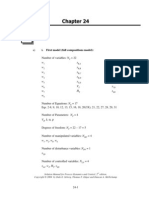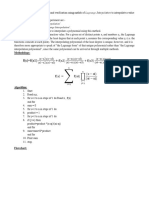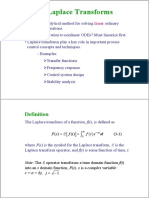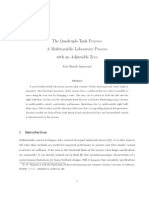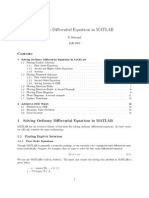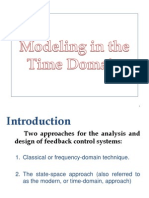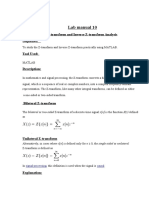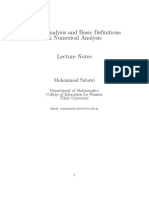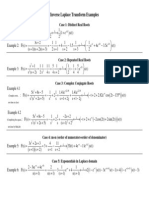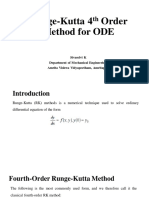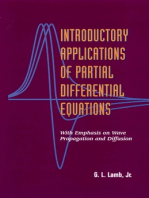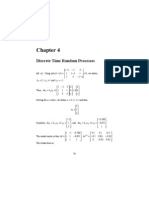Inverse Laplace Transform Lecture-3
Inverse Laplace Transform Lecture-3
Uploaded by
SingappuliCopyright:
Available Formats
Inverse Laplace Transform Lecture-3
Inverse Laplace Transform Lecture-3
Uploaded by
SingappuliOriginal Description:
Copyright
Available Formats
Share this document
Did you find this document useful?
Is this content inappropriate?
Copyright:
Available Formats
Inverse Laplace Transform Lecture-3
Inverse Laplace Transform Lecture-3
Uploaded by
SingappuliCopyright:
Available Formats
By Mr S M Wijewardana
PhD student QMUL
12-04-2013
Learning Objectives:
1. Introduction to Inverse Laplace Transform
2. Three Methods used to find Inverse Laplace Transform
3. Initial value theorem and the Final value theorem
4. Examples on Inverse Laplace Transform
5. Eigenvalues and Eigenvectors.
Given the Laplace transform F(s), the reverse process of
finding f(t) is called Inverse Laplace Transform.
f(t) =
-1
[F(s)]
Inverse Laplace transform contains no information about
the initial condition. Because Inverse Laplace transform
yields the response for t>0, and the Laplace transform
method is capable of solving problems in which there is a
discontinuity at the origin.
f(0
-
) f(0
+
) Hence, f(0
+
) is not the initial value f(0).
Three main Methods
1. Partial Fraction Method 2.Method of Residues
3.Convplution integral method.
Initiaal and Final Value Theorems
Final Value Theorem- determine the steady-state value
of the system response without finding the inverse
Laplace transform.
Procedure: 1) find the transfer function X (s)
2) multiply X(s) by s
3) take the limit of s X(s) as s goes to zero
4) result is the value of x(t) when t = infinity
Initial Value Theorem- determine the value of the time
Function when t =0 without finding the inverse transform
Procedure: 1) find the transfer function X(s)
2) multiply X(s)b y s
3) take the limit of sX(s) as S
goes to infinity
4) Result is the value of x(t) when t =0
lim x(t) = lim s.X(s)
t goes to 0 then s reaches to infinity
Partial Fraction Method
) 2 )( 1 (
2
) (
+ +
=
s s
s F
Example: Given
Find the time domain function using partial fraction method.
) 2 ( ) 1 ( ) 2 )( 1 (
2
) (
+
+
+
=
+ +
=
s
B
s
A
s s
s F Let
A & B are constants
Multiplying by(s+1)(s+2) both sides of the equation
gives:
2 = A(s+2) + B(s+1)
When s=-2, B= -2: When s=-1, A=2
) 2 (
2
) 1 (
2
) (
+
+
=
s s
s F
By using Inverse Laplace Transform table we can write:
f(t) = 2 e
-t
- 2 e
-2t
G(s)
Input
Output = C(s)
R(s)
Plant
Block diagram represents a simple open-
loop transfer function. Find the time
response of the system if:
) 6 )( 4 (
) 2 (
) (
+ +
+
=
s s
s
s G
Output = Input . G(s)
Hence C(s) = R(s).G(s)
) 6 )( 4 (
) 2 (
.
1
) (
+ +
+
=
s s
s
s
s C
Applying the Initial-value theorem:
) ( lim
lim
) (
0
s sF
s
t
t f
=
) ( lim
lim
) (
0
s sF
s
t
t f
=
e.g.
Solution:
) ( lim
lim
)] ( [
0
s sC
s
t
t C
=
Applying the Final value theorem:
Final value theorem can be applied only if the Laplace transform of f(t) is F(s)
and if sF(s) is analytic on the imaginary axis and in the right half of s-
plane.
0
1
0
24 10
1
2 1
lim
) 6 )( 4 (
) 2 (
lim
2
2
= = =
+ +
+
=
)
`
+ +
+
=
value Initial
s
s
s
s
s s s
s s
s
s
) ( lim
lim
0
)] ( [
s sF
s
t f
t
=
Analytic: take it as convergent function for the time being.
The function G(s):
Is an analytic function at all points in the s-plane except s=-4 and s=-6
Since sF(s) is analytic on the imaginary axis and in the right half of s-
plane, the final-value theorem can be applied.
Therefore:
) 6 )( 4 (
) 2 (
) (
+ +
+
=
s s
s
s G
) ( lim
lim
0
)] ( [
s sC
s
t C
t
=
) 6 )( 4 (
) 2 (
lim
) 6 )( 4 (
) 2 (
lim
0
0
+ +
+
=
+ +
+
=
s s
s
s s s
s s
s
s
Hence the final value(F.V) = 1/12
) 6 ( ) 4 ( ) 6 )( 4 (
) 2 (
) (
+
+
+
+ =
+ +
+
=
s
C
s
B
s
A
s s s
s
s C
By obtaining the partial fractions of C(s) : (A,B,C are constants.
(s+2) =A(s+4)(s+6) + Bs(s+6) + Cs(s+4)
From which A=1/12, B= =1/4, C= -1/3
) 6 ( ) 4 (
) (
3
1
4
1
12
1
+
+
+ =
s s s
s C
By taking Inverse Laplace Transform:
t t
e e t c
6 4
3
1
4
1
12
1
) (
+ =
Since we know the initial value and
the final value of c(t) now we can plot
the graph of c(t) vs t
t
C(t)
1/12
0
k
S S
st n
k
n
n
k
e s F s s
ds
d
n
Rs
=
= ). ( ) (
) 1 ( !
1
1
1
Method of Residues:
Method of residues gives the inverse Laplace Transform of functions with
coefficients. This method is useful to find the Inverse Laplace transform
when the Laplace transform functions are not available in the tables.
The numbers associated with the poles of a function are known as function
residues
The Residue theorem states that if F(s) is a rational function then
inverse Laplace transform of a function is given by:
Poles all
st
e s F of sidues ] ). ( [Re
-1
[F(s)] =
Where the residue, Rs
K
of nth order pole at S= -S
k
is obtained by:
(Rational function has a numerator and a denominator and it is like a ratio of
two polynomial functions: rational number means it can be written as a fraction:
Sqrt of 2 is an irrational number)
Use method of residues to determine the
time function
-1
[F(s)] =
-1
]
) 4 )( 3 )( 2 (
6 6
[
2
+ + +
+ +
s s s
s s
The function F(s) has poles at s=-2, s=-3 and s=-4:
assume the residues are R-2, R-3 and R-4
t t st
e e
s s
s s
e R
s
2 2
2
2
.
2
2
) 4 )( 3 (
6 6
.
2
=
(
+ +
+ +
=
=
t t st
e e
s s
s s
e R
s
3 3
2
3
3 .
1
3
) 4 )( 3 (
6 6
.
3
=
(
+ +
+ +
=
=
t st
e
s s
s s
e R
s
4
2
4
. 1
) 4 )( 3 (
6 6
.
4
=
(
+ +
+ +
=
=
Hence the required time function
f(t) = -[e
-2t
-3e
-3t
+e
-4t
]
Convolution Theorem
Theorem says that if [f
1
(t)] = F
1
(s) and [f
2
(t)]= F
2
(s) and f
1
(t) =0,f
2
(t)= 0,
for t<0 then:
F1(s) F2(s) = [f
1
(t) * f
2
(t)] ( * symbol for convolution)
(
}
t
d t f f
0
2 1
). ( ) ( t t t
=
Example:
) 2 )( 1 (
2
) (
+ +
=
s s
s F
Solution:
) 2 (
1
) ( ,
) 1 (
2
) (
2 1
+
=
+
=
s
s F
s
s F Let
By substituting t= (t-) and t= in f1 and f2 respectively
}
=
t
t
d e e t f theorem n Convolutio by Now
0
2 ) (
. . 2 ) ( t
t t
From tables: f
1
(t)= 2e
-t
, f
2
(t)= e
-2t
f
1
(t-) =2 e
-(t-)
,
f
2
=e
-2
t
t
d e e
t
t
. 2
0
}
t t
t t
t
t
t
e e
e e e
t
e e
d e e
2
0
0
2 2
)] / 1 ( [ 2
0
] [ 2
. 2
=
=
=
}
t
t
t
Eigenvalues and Eigenvectors
If A is a n by n matrix and X is a column vector of order n, we can generate a new
column vector Y by multiplication.
Y= AX
If we consider that Y also in the same direction as of X, then we should be able to
represent Y, as a scalar quantity(say ) multiplied by the vector X such that Y is
linearly related to X.
Hence we should be able to write that:
Y = A X = X
The values of that satisfy the above equation are the characteristic values of A.
The vector solution x
i
0, are called the eigenvectors of A.
(A- I)X= 0 or (I-A)X=0
Example: (Eigenvalues)
If we have Y = AX and AX = X for non zero Xs if and only if
det(I
n
-A) = 0 then is called the eigenvalues of A.
(
=
3 4
2 1
A
Find the eigenvalues of A
Solution:
For nontrivial null space (I-A):
0
3 4 0
2 0 1
det
0
3 4
2 1
0
0
det
0 )
3 4
2 1
1 0
0 1
det(
=
|
|
.
|
\
|
(
=
|
|
.
|
\
|
(
=
(
(-1)(-3)-8 =0
We call the equation that we get is the Characteristic Polynomial:
2
-4-5 =0
(-5)(+1)=0
Which gives us =5 and = -1 which are the eigenvalues of A
(
2 2
2 5
A=
Example: Compute eigenvalues and eigenvectors for the matrix A:
(Definition: (you may need to revise)Homogeneous: a collection of linear equations or a set of
linear equations):
Singular matrix: a square matrix whose determinant is zero.
-----------------------------------------------------------------------------------------------
(
=
3 4
2 1
A
Another method:
Solution: it can be shown that eigenvalues give the addition along the diagonal
matrix of the singular matrix: 1 + 2 = 4: Other relationship is the
Determinant is equal to the multiple of the two eigenvalues: 1 . 2 = 3-4x2 = -5
By solving the two equations we get the same answers : Eigenvalues, 5 and -1.
Solution:
We know that:
Ax = x for non zero x, iff det(I
n
-A) =0;
(
2 2
2 5
A =
Example:
(A-I) x = 0
x is the eigenvector and it must be a column
vector with x
1
and x
2
etc.
Compute the eigenvalues and
eigenvectors.
Solution: part-1 :eigenvalue
We know that:
Ax = x for non zero x, iff det(I
n
-A) =0; is an eigenvalue.
To find eigenvalue det (I
n
-A) =0
Or we can write: det (A-I
n
) =0 : A=
To compute corresponding
eigenvectors: (A-I) x = 0
Take = 6 first:
(
2 2
2 5
1 , 6
0 ) 1 )( 6 (
2 2
2 5
0
=
=
= =
I A or
0
2 2
2 5
0
1 0
0 1
2 2
2 5
=
(
=
(
| || |
(
(
=
(
=
=
(
0
0
4 2
2 1
6
0
2 2
2 5
0
12
11
12
11
x
x
x
x
x I A
From which: -x
11
+ 2x
12
=0 and
2x
11
- 4x
12
=0(same as above)
Therefore x
11
= 2x
12
, choose x12=1 then x11=2
Hence eigenvector
(
1
2
*
x
When = 1
22 21
22 21
22
21
22
21
2
0 2 4
0
0
1 2
2 4
0
0
2 2
2 5
x x
x x
x
x
x
x
=
= +
(
=
(
=
(
Choose x
22
=-2 then x
21
= 1
Hence the other eigenvector
(
1
2
* *
x
Pictorial representation of Eigenvectors
Learning Outcomes
1. Method of residues
2.Partial fraction method
3. Application of Initial Value theorem & Final Value
theorem
4. Convolution theorem and the limitations of Inverse
Laplace transform
5.Use of mathematical function in control theory.
6.Eigenvalues and Eigenvectors
You might also like
- A2 Schreiben PDFDocument3 pagesA2 Schreiben PDFnajia safiNo ratings yet
- Process Dynamics and Control, Ch. 24 Solution ManualDocument27 pagesProcess Dynamics and Control, Ch. 24 Solution ManualBen Spearman100% (1)
- Transient and Steady-State Response AnalysisDocument9 pagesTransient and Steady-State Response Analysisfarouq_razzaz2574No ratings yet
- 13 Problem Solving With MATLAB PDFDocument64 pages13 Problem Solving With MATLAB PDFAugusto De La Cruz CamayoNo ratings yet
- ClassLectures Numerical MethodsDocument84 pagesClassLectures Numerical MethodsFaisal Baig50% (2)
- Step Functions and Laplace Transforms of Piecewise Continuous FunctionsDocument20 pagesStep Functions and Laplace Transforms of Piecewise Continuous FunctionsLemuel C. FernandezNo ratings yet
- Lagrange InterpolationDocument3 pagesLagrange Interpolationanis anis100% (1)
- CL7101-Control System DesignDocument8 pagesCL7101-Control System DesigndhineshpNo ratings yet
- Laplace Transforms: LinearDocument11 pagesLaplace Transforms: Linear李承家No ratings yet
- State Errors - Steady: Eman Ahmad KhalafDocument28 pagesState Errors - Steady: Eman Ahmad KhalafAhmed Mohammed khalfNo ratings yet
- Development of Empirical Models From Process Data: - An Attractive AlternativeDocument10 pagesDevelopment of Empirical Models From Process Data: - An Attractive Alternative李承家No ratings yet
- Signal and Systems For ScilabDocument194 pagesSignal and Systems For ScilabAndres Felipe Amaya LeonNo ratings yet
- Rosen Gradient Projection MethodDocument7 pagesRosen Gradient Projection MethodSreevatsanadigNo ratings yet
- Lab-4 (Solution by Adnan)Document11 pagesLab-4 (Solution by Adnan)Muhammad Adnan0% (1)
- The Quadruple-Tank Process - JohanssonDocument24 pagesThe Quadruple-Tank Process - JohanssonosmaanNo ratings yet
- Lab Experiment 11Document10 pagesLab Experiment 11Sohail Afridi100% (1)
- Unit Step Function in MatlabDocument6 pagesUnit Step Function in Matlabshaista005100% (3)
- Control Theory Quiz 1Document5 pagesControl Theory Quiz 1Sundas Khalid100% (1)
- 1st Project-2D HT in SQR Plate With MATLAB PDFDocument11 pages1st Project-2D HT in SQR Plate With MATLAB PDFAhmadreza AminianNo ratings yet
- Response of First OrderDocument4 pagesResponse of First Order阿尔坎塔拉约翰·肯尼斯No ratings yet
- Process Dynamics and Control - Ch05Document20 pagesProcess Dynamics and Control - Ch05etayhailuNo ratings yet
- Tutorial Problems in Numerical MethodsDocument8 pagesTutorial Problems in Numerical MethodsvignanarajNo ratings yet
- Matlab Project Section B1Document50 pagesMatlab Project Section B1Biruk TadesseNo ratings yet
- Tutorial 2Document7 pagesTutorial 2Ahmed AlwaqediNo ratings yet
- III Dynamic Process ModelDocument26 pagesIII Dynamic Process ModelIshita BhattacharyyaNo ratings yet
- Lecture Note Chapter 11 PID Controller Design Tuning and Troubleshooting 2016Document61 pagesLecture Note Chapter 11 PID Controller Design Tuning and Troubleshooting 2016Rama KrishnaNo ratings yet
- Edc 46Document87 pagesEdc 46nagarjunaNo ratings yet
- Numerical Lab ReportDocument5 pagesNumerical Lab ReportSarwar Hosen SimonNo ratings yet
- Chapter 3 - Continuously Process ControlDocument84 pagesChapter 3 - Continuously Process ControlVon Jin100% (1)
- Applications Taylor SeriesDocument5 pagesApplications Taylor Seriesrjpatil19No ratings yet
- Matlab Methods For OdeDocument16 pagesMatlab Methods For OdeGrassrehLeNo ratings yet
- Curve Fitting, B-Splines & ApproximationsDocument14 pagesCurve Fitting, B-Splines & ApproximationsGetsuga TenshouNo ratings yet
- 74LS138Document5 pages74LS138jidul16No ratings yet
- Labrpt2 Math505 New FormatDocument5 pagesLabrpt2 Math505 New Formatمبنيةنميب نتمبيةنNo ratings yet
- Fluid ProjectDocument45 pagesFluid ProjectDhiraj Nayak0% (1)
- Lecture 3 - Chapter 3 (Modeling in The Time Domain)Document57 pagesLecture 3 - Chapter 3 (Modeling in The Time Domain)Jessiedee Mark GingoNo ratings yet
- Chapter 1Document15 pagesChapter 1ُIBRAHEEM ALHARBINo ratings yet
- Laplace Transform: 2.1 What Are Laplace Transforms, and Why?Document23 pagesLaplace Transform: 2.1 What Are Laplace Transforms, and Why?AHMED ALI S ALAHMADINo ratings yet
- Understanding Pole-Zero Plots On The S PlaneDocument7 pagesUnderstanding Pole-Zero Plots On The S PlaneGwenShepherdNo ratings yet
- Signal and System LabsDocument158 pagesSignal and System LabsAbdur RahmanNo ratings yet
- Lab Manual 10: Z-Transform and Inverse Z-Transform Analysis ObjectiveDocument7 pagesLab Manual 10: Z-Transform and Inverse Z-Transform Analysis ObjectiveSyed Waqas ShahNo ratings yet
- Errors Analysis and Basic Definitions in Numerical AnalysisDocument14 pagesErrors Analysis and Basic Definitions in Numerical AnalysisAdeena SiddiquiNo ratings yet
- Inverse Laplace Transform ExamplesDocument1 pageInverse Laplace Transform ExamplesAhmed AlNo ratings yet
- EE Lab Manuls Fast NuDocument83 pagesEE Lab Manuls Fast NuMuhammad SaadNo ratings yet
- 8.condensed Matter Physics NET-JRF VKSDocument27 pages8.condensed Matter Physics NET-JRF VKSbadochutiyo0% (1)
- RK 4th Order MethodDocument20 pagesRK 4th Order Methodaaron mathewsNo ratings yet
- False Position MethodDocument8 pagesFalse Position Methodmuzamil hussainNo ratings yet
- Inverse LaplaceDocument19 pagesInverse LaplaceSudeep KhareNo ratings yet
- Control of Multiple-Input, Multiple-Output (MIMO) ProcessesDocument38 pagesControl of Multiple-Input, Multiple-Output (MIMO) Processessalvador2meNo ratings yet
- Chapter 2 Solution - Matlab Programming With Applications For EngineersDocument7 pagesChapter 2 Solution - Matlab Programming With Applications For EngineersCarolMichalskiNo ratings yet
- Control System Lab Manual Revised Version Winter 2017Document75 pagesControl System Lab Manual Revised Version Winter 2017Sôhåîß KhåñNo ratings yet
- Matlab Tutorial 2Document7 pagesMatlab Tutorial 2Shivram TabibuNo ratings yet
- Secant MethodDocument5 pagesSecant MethodLn Amitav BiswasNo ratings yet
- PC Lab ManualDocument47 pagesPC Lab ManualAoiNo ratings yet
- Introductory Applications of Partial Differential Equations: With Emphasis on Wave Propagation and DiffusionFrom EverandIntroductory Applications of Partial Differential Equations: With Emphasis on Wave Propagation and DiffusionNo ratings yet
- Chapter 3 (Seborg Et Al.)Document20 pagesChapter 3 (Seborg Et Al.)Jamel CayabyabNo ratings yet
- Chapter 4 - Solved Problems: Solutions To Solved Problem 4.1Document12 pagesChapter 4 - Solved Problems: Solutions To Solved Problem 4.1cilentNo ratings yet
- Discrete Time Random Processes: 4.1 (A) UsingDocument16 pagesDiscrete Time Random Processes: 4.1 (A) UsingSudipta GhoshNo ratings yet
- Laplace TransformationDocument13 pagesLaplace TransformationAtikah JNo ratings yet
- Chapter 7 4Document22 pagesChapter 7 4Muhd RzwanNo ratings yet
- Chapter 3 Laplace TransformDocument20 pagesChapter 3 Laplace TransformKathryn Jing LinNo ratings yet
- State Space Many MethodsDocument20 pagesState Space Many MethodsSingappuliNo ratings yet
- State Space Representation Part-1Document47 pagesState Space Representation Part-1SingappuliNo ratings yet
- Signal Flow DiagramsDocument20 pagesSignal Flow DiagramsSingappuliNo ratings yet
- Block Diagrams Control SystemsDocument25 pagesBlock Diagrams Control SystemsSingappuliNo ratings yet
- Application of Laplace TransformDocument35 pagesApplication of Laplace TransformSingappuli100% (1)
- Control Systems EngineeringDocument32 pagesControl Systems EngineeringSingappuli100% (2)
- Mechanical (Including Torque) (Crankshaft Main Bearing) - ALLDATA Repair Sienna 3.5LtsDocument3 pagesMechanical (Including Torque) (Crankshaft Main Bearing) - ALLDATA Repair Sienna 3.5LtsFran SanchezNo ratings yet
- Raspberry Pi 2 3Document4 pagesRaspberry Pi 2 3EricNo ratings yet
- تجارب مختبر Plc+تقاريرDocument40 pagesتجارب مختبر Plc+تقاريرenre jasmNo ratings yet
- Uncertain Activity Duration: Consider The IS Development Project Network Given Below: 3 A C E GDocument18 pagesUncertain Activity Duration: Consider The IS Development Project Network Given Below: 3 A C E GgimanuNo ratings yet
- Criteria For Assessment: Statement of The Problem and ResearchDocument5 pagesCriteria For Assessment: Statement of The Problem and ResearchDagnachew Amare DagnachewNo ratings yet
- Manual de Instalacion Clopay Break Away PDFDocument3 pagesManual de Instalacion Clopay Break Away PDFAlexander Rivero ReyesNo ratings yet
- Halliburton Success Stories 2-12-15Document3 pagesHalliburton Success Stories 2-12-15Cesar G.No ratings yet
- Wiley Edge Alumni Brochure UKDocument23 pagesWiley Edge Alumni Brochure UKSignoreNo ratings yet
- Water Tank Price List Vizag Nellore LDocument2 pagesWater Tank Price List Vizag Nellore LShaik ImamNo ratings yet
- Lab Prob 12 Saphir Various Well Tests 2023Document9 pagesLab Prob 12 Saphir Various Well Tests 2023Richard OwusuNo ratings yet
- 9 - Electrical FaultDocument24 pages9 - Electrical Faultmohamed ghoneemNo ratings yet
- A Computer Scientist On The Side of EvilDocument6 pagesA Computer Scientist On The Side of EvilScribdTranslationsNo ratings yet
- QMS-01 Issue 2 Rev 0 Procedure For QMS Management ReviewDocument11 pagesQMS-01 Issue 2 Rev 0 Procedure For QMS Management ReviewbanglvhNo ratings yet
- Tech Note 1010 - SQL Server Authentication and ArchestrA Network Account Restrictions When Installing Wonderware HistorianDocument8 pagesTech Note 1010 - SQL Server Authentication and ArchestrA Network Account Restrictions When Installing Wonderware Historianprofilemail8No ratings yet
- PWC Breakthrough Innovation and GrowthDocument44 pagesPWC Breakthrough Innovation and Growthjimmy0000007100% (1)
- Pfaudler FittingsDocument6 pagesPfaudler FittingsGustavo FamaNo ratings yet
- Data Analytics InternDocument42 pagesData Analytics Interndinesh2730tNo ratings yet
- Commission Sheet Template 07Document9 pagesCommission Sheet Template 07RonNo ratings yet
- Go First - Airline Tickets and Fares - Boarding PassDocument2 pagesGo First - Airline Tickets and Fares - Boarding PassShaikh RoshanNo ratings yet
- Probability Review À Markov Models: CSE 473: Artificial IntelligenceDocument23 pagesProbability Review À Markov Models: CSE 473: Artificial IntelligenceGODFREYNo ratings yet
- Inmv Toyota PDFDocument32 pagesInmv Toyota PDFShifat UllahNo ratings yet
- FR19 - Flame Resistant Anti-Static Neck Tube Modaflame KnitDocument2 pagesFR19 - Flame Resistant Anti-Static Neck Tube Modaflame KnitHernando OrozcoNo ratings yet
- Incorrect Naming-22.04.24Document12 pagesIncorrect Naming-22.04.24Doddy KurniawanNo ratings yet
- The Official ScratchJr Book Help Your Kids Learn to Code 1st Edition Marina Umaschi Bers 2024 Scribd DownloadDocument55 pagesThe Official ScratchJr Book Help Your Kids Learn to Code 1st Edition Marina Umaschi Bers 2024 Scribd Downloadboberfolgave100% (4)
- Compressor Limiter 522 - QSG - enDocument15 pagesCompressor Limiter 522 - QSG - enDrixNo ratings yet
- (COSMOS Certi) 1,3-B.G - 21.12.31Document2 pages(COSMOS Certi) 1,3-B.G - 21.12.31Nindy Dellia PutriNo ratings yet
- Moment Generating FunctionsDocument7 pagesMoment Generating Functionsabdullaalayan000No ratings yet
- Ims Operation Manual Business Development & Corporate Strategy (BD&CS) DepartmentDocument7 pagesIms Operation Manual Business Development & Corporate Strategy (BD&CS) DepartmentAkd DeshmukhNo ratings yet
- 4th Module Assessment (28 Marks) Unix Linux Programming (CSIT803) - Semester IIIDocument9 pages4th Module Assessment (28 Marks) Unix Linux Programming (CSIT803) - Semester IIIsayshahbazzNo ratings yet

